Design-Build vs Traditional Procurement in NZ: A Comparative Report
VerifiedAdded on 2023/06/13
|35
|12321
|69
Report
AI Summary
This document is an owner's guide to project delivery methods, focusing on the decision-making process for selecting the most appropriate method for construction projects. It begins by acknowledging the contributors and outlining the purpose of the guide, which is to provide a comparison among various delivery methods, their pros and cons, and the role of program managers or agency construction managers. The guide covers key considerations such as owner's requirements, risk assessment, and the level of expertise available. It delves into four primary project delivery methods: Design-Bid-Build (DBB), Construction Management at Risk (CMAR), Design-Build (DB), and Integrated Project Delivery (IPD). Each method's characteristics, risk levels, and advantages and disadvantages are objectively presented. The guide also touches on contracting alternatives and procurement strategies, emphasizing that the selection of the right delivery method requires expertise and experience. It concludes by highlighting the importance of Construction Management as a discipline tailored to the planning, design, and construction process, whether through internal staffing or third-party firms, to guide and assist the owner through all project phases.
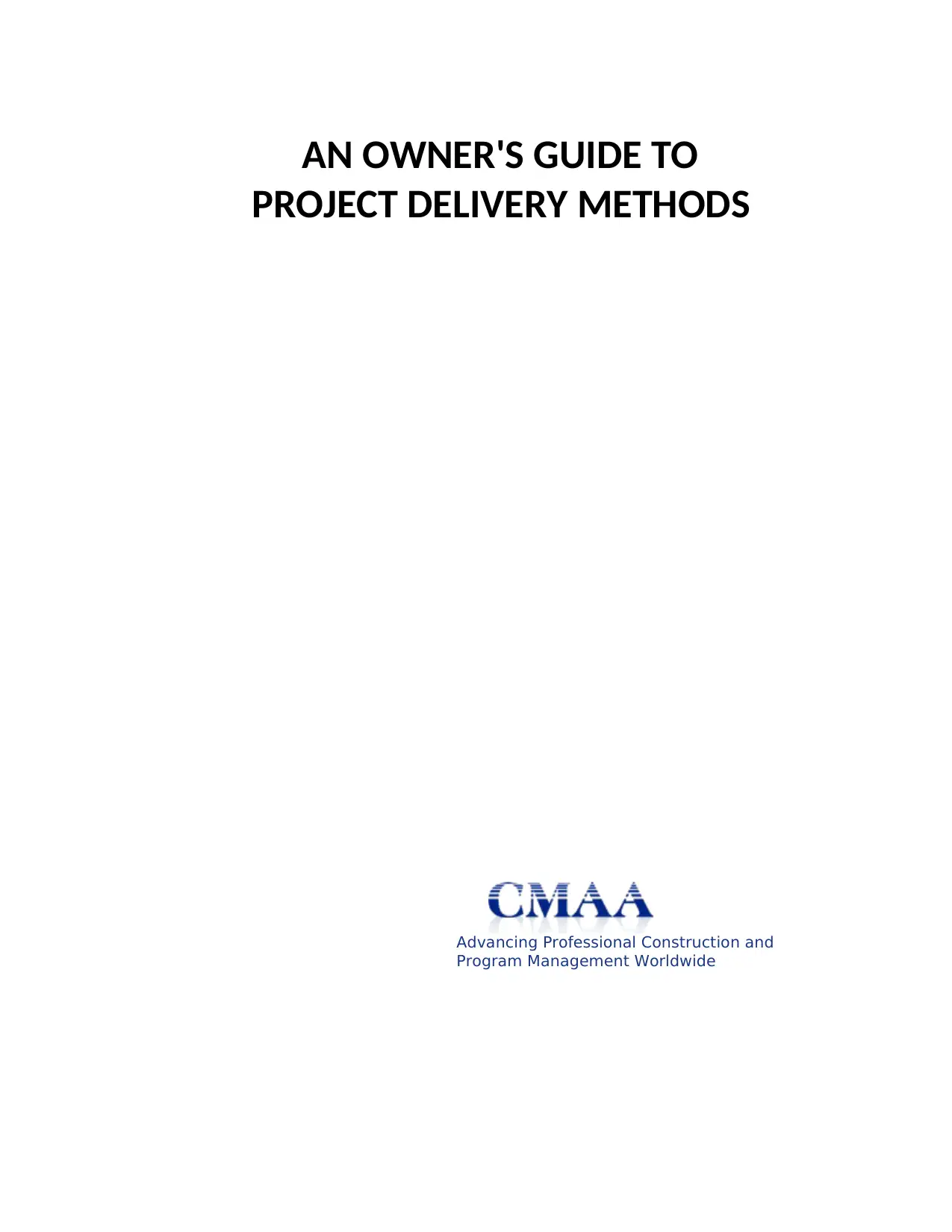
AN OWNER'S GUIDE TO
PROJECT DELIVERY METHODS
Advancing Professional Construction and
Program Management Worldwide
PROJECT DELIVERY METHODS
Advancing Professional Construction and
Program Management Worldwide
Paraphrase This Document
Need a fresh take? Get an instant paraphrase of this document with our AI Paraphraser

ACKNOWLEDGMENTS
CMAA gratefully acknowledges the time and efforts of those who served as contributing editors in
developing this Owner’s Guide to Project Delivery Methods. Without the collective efforts of these
individuals, this document would not have been possible.
Copyright 2012
The Construction Management Association of America
All Rights Reserved
CMAA gratefully acknowledges the time and efforts of those who served as contributing editors in
developing this Owner’s Guide to Project Delivery Methods. Without the collective efforts of these
individuals, this document would not have been possible.
Copyright 2012
The Construction Management Association of America
All Rights Reserved
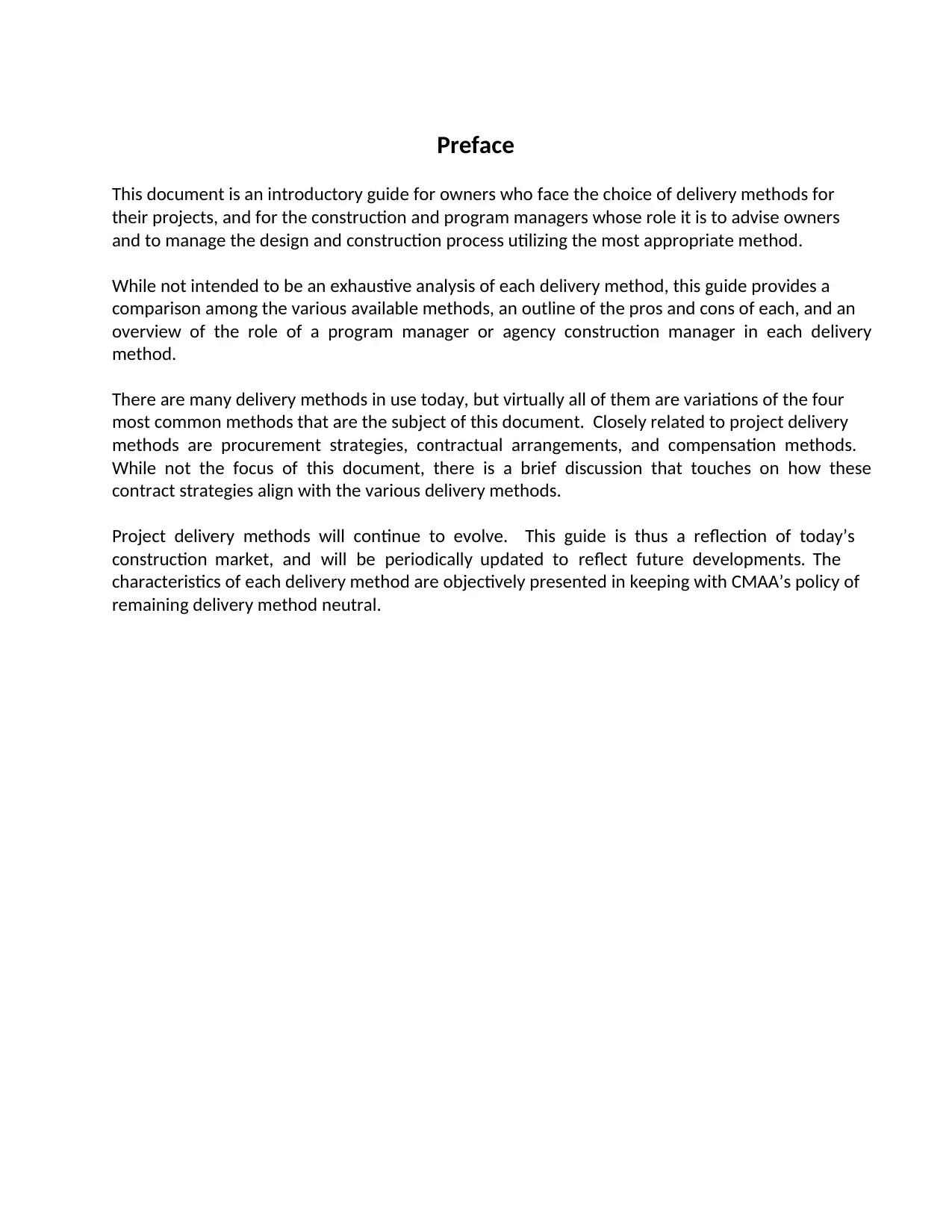
Preface
This document is an introductory guide for owners who face the choice of delivery methods for
their projects, and for the construction and program managers whose role it is to advise owners
and to manage the design and construction process utilizing the most appropriate method.
While not intended to be an exhaustive analysis of each delivery method, this guide provides a
comparison among the various available methods, an outline of the pros and cons of each, and an
overview of the role of a program manager or agency construction manager in each delivery
method.
There are many delivery methods in use today, but virtually all of them are variations of the four
most common methods that are the subject of this document. Closely related to project delivery
methods are procurement strategies, contractual arrangements, and compensation methods.
While not the focus of this document, there is a brief discussion that touches on how these
contract strategies align with the various delivery methods.
Project delivery methods will continue to evolve. This guide is thus a reflection of today’s
construction market, and will be periodically updated to reflect future developments. The
characteristics of each delivery method are objectively presented in keeping with CMAA’s policy of
remaining delivery method neutral.
This document is an introductory guide for owners who face the choice of delivery methods for
their projects, and for the construction and program managers whose role it is to advise owners
and to manage the design and construction process utilizing the most appropriate method.
While not intended to be an exhaustive analysis of each delivery method, this guide provides a
comparison among the various available methods, an outline of the pros and cons of each, and an
overview of the role of a program manager or agency construction manager in each delivery
method.
There are many delivery methods in use today, but virtually all of them are variations of the four
most common methods that are the subject of this document. Closely related to project delivery
methods are procurement strategies, contractual arrangements, and compensation methods.
While not the focus of this document, there is a brief discussion that touches on how these
contract strategies align with the various delivery methods.
Project delivery methods will continue to evolve. This guide is thus a reflection of today’s
construction market, and will be periodically updated to reflect future developments. The
characteristics of each delivery method are objectively presented in keeping with CMAA’s policy of
remaining delivery method neutral.
⊘ This is a preview!⊘
Do you want full access?
Subscribe today to unlock all pages.

Trusted by 1+ million students worldwide
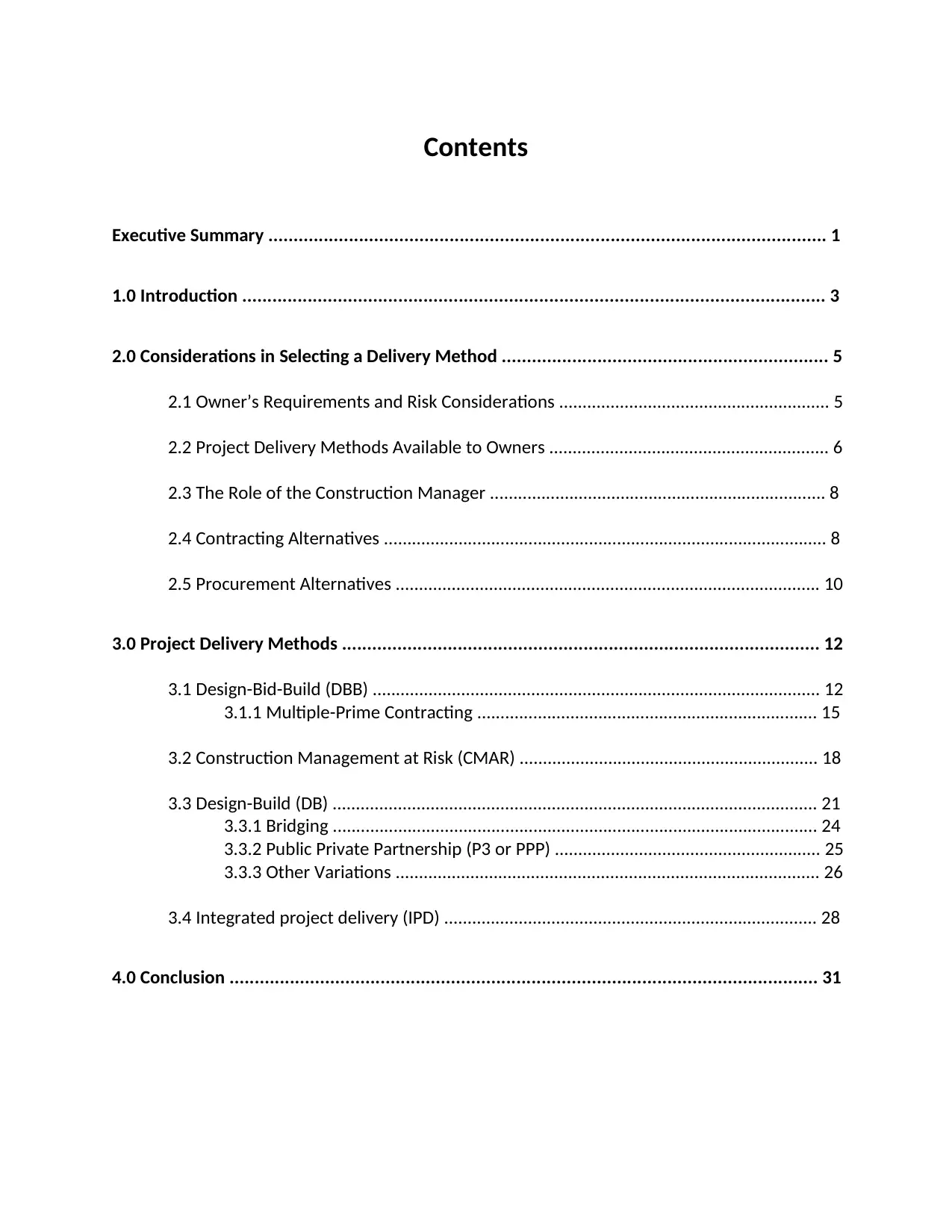
Contents
Executive Summary ............................................................................................................... 1
1.0 Introduction .................................................................................................................... 3
2.0 Considerations in Selecting a Delivery Method ................................................................. 5
2.1 Owner’s Requirements and Risk Considerations .......................................................... 5
2.2 Project Delivery Methods Available to Owners ............................................................ 6
2.3 The Role of the Construction Manager ........................................................................ 8
2.4 Contracting Alternatives ............................................................................................... 8
2.5 Procurement Alternatives ........................................................................................... 10
3.0 Project Delivery Methods ............................................................................................... 12
3.1 Design-Bid-Build (DBB) ................................................................................................ 12
3.1.1 Multiple-Prime Contracting ......................................................................... 15
3.2 Construction Management at Risk (CMAR) ................................................................ 18
3.3 Design-Build (DB) ........................................................................................................ 21
3.3.1 Bridging ........................................................................................................ 24
3.3.2 Public Private Partnership (P3 or PPP) ......................................................... 25
3.3.3 Other Variations ........................................................................................... 26
3.4 Integrated project delivery (IPD) ................................................................................ 28
4.0 Conclusion ..................................................................................................................... 31
Executive Summary ............................................................................................................... 1
1.0 Introduction .................................................................................................................... 3
2.0 Considerations in Selecting a Delivery Method ................................................................. 5
2.1 Owner’s Requirements and Risk Considerations .......................................................... 5
2.2 Project Delivery Methods Available to Owners ............................................................ 6
2.3 The Role of the Construction Manager ........................................................................ 8
2.4 Contracting Alternatives ............................................................................................... 8
2.5 Procurement Alternatives ........................................................................................... 10
3.0 Project Delivery Methods ............................................................................................... 12
3.1 Design-Bid-Build (DBB) ................................................................................................ 12
3.1.1 Multiple-Prime Contracting ......................................................................... 15
3.2 Construction Management at Risk (CMAR) ................................................................ 18
3.3 Design-Build (DB) ........................................................................................................ 21
3.3.1 Bridging ........................................................................................................ 24
3.3.2 Public Private Partnership (P3 or PPP) ......................................................... 25
3.3.3 Other Variations ........................................................................................... 26
3.4 Integrated project delivery (IPD) ................................................................................ 28
4.0 Conclusion ..................................................................................................................... 31
Paraphrase This Document
Need a fresh take? Get an instant paraphrase of this document with our AI Paraphraser
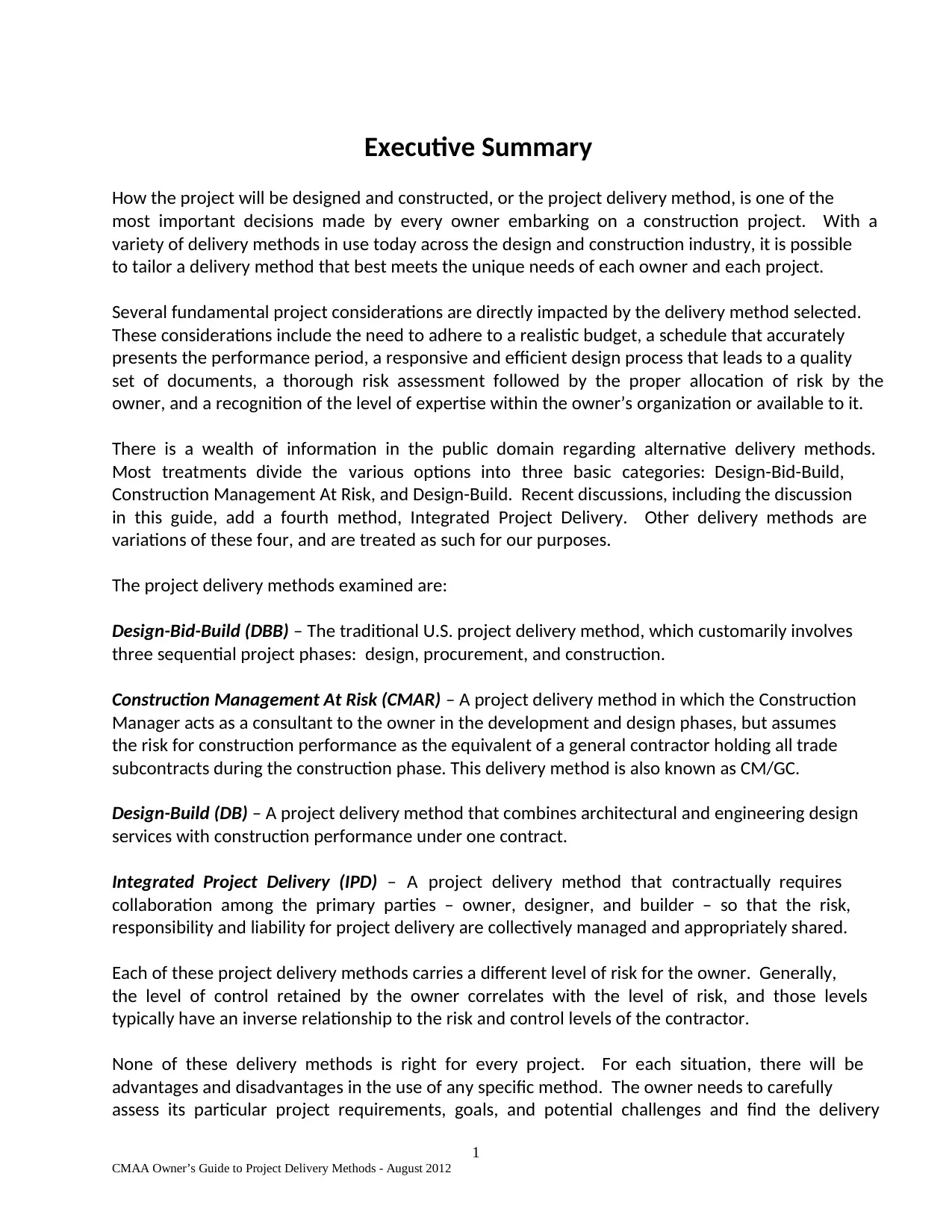
1
CMAA Owner’s Guide to Project Delivery Methods - August 2012
Executive Summary
How the project will be designed and constructed, or the project delivery method, is one of the
most important decisions made by every owner embarking on a construction project. With a
variety of delivery methods in use today across the design and construction industry, it is possible
to tailor a delivery method that best meets the unique needs of each owner and each project.
Several fundamental project considerations are directly impacted by the delivery method selected.
These considerations include the need to adhere to a realistic budget, a schedule that accurately
presents the performance period, a responsive and efficient design process that leads to a quality
set of documents, a thorough risk assessment followed by the proper allocation of risk by the
owner, and a recognition of the level of expertise within the owner’s organization or available to it.
There is a wealth of information in the public domain regarding alternative delivery methods.
Most treatments divide the various options into three basic categories: Design-Bid-Build,
Construction Management At Risk, and Design-Build. Recent discussions, including the discussion
in this guide, add a fourth method, Integrated Project Delivery. Other delivery methods are
variations of these four, and are treated as such for our purposes.
The project delivery methods examined are:
Design-Bid-Build (DBB) – The traditional U.S. project delivery method, which customarily involves
three sequential project phases: design, procurement, and construction.
Construction Management At Risk (CMAR) – A project delivery method in which the Construction
Manager acts as a consultant to the owner in the development and design phases, but assumes
the risk for construction performance as the equivalent of a general contractor holding all trade
subcontracts during the construction phase. This delivery method is also known as CM/GC.
Design-Build (DB) – A project delivery method that combines architectural and engineering design
services with construction performance under one contract.
Integrated Project Delivery (IPD) – A project delivery method that contractually requires
collaboration among the primary parties – owner, designer, and builder – so that the risk,
responsibility and liability for project delivery are collectively managed and appropriately shared.
Each of these project delivery methods carries a different level of risk for the owner. Generally,
the level of control retained by the owner correlates with the level of risk, and those levels
typically have an inverse relationship to the risk and control levels of the contractor.
None of these delivery methods is right for every project. For each situation, there will be
advantages and disadvantages in the use of any specific method. The owner needs to carefully
assess its particular project requirements, goals, and potential challenges and find the delivery
CMAA Owner’s Guide to Project Delivery Methods - August 2012
Executive Summary
How the project will be designed and constructed, or the project delivery method, is one of the
most important decisions made by every owner embarking on a construction project. With a
variety of delivery methods in use today across the design and construction industry, it is possible
to tailor a delivery method that best meets the unique needs of each owner and each project.
Several fundamental project considerations are directly impacted by the delivery method selected.
These considerations include the need to adhere to a realistic budget, a schedule that accurately
presents the performance period, a responsive and efficient design process that leads to a quality
set of documents, a thorough risk assessment followed by the proper allocation of risk by the
owner, and a recognition of the level of expertise within the owner’s organization or available to it.
There is a wealth of information in the public domain regarding alternative delivery methods.
Most treatments divide the various options into three basic categories: Design-Bid-Build,
Construction Management At Risk, and Design-Build. Recent discussions, including the discussion
in this guide, add a fourth method, Integrated Project Delivery. Other delivery methods are
variations of these four, and are treated as such for our purposes.
The project delivery methods examined are:
Design-Bid-Build (DBB) – The traditional U.S. project delivery method, which customarily involves
three sequential project phases: design, procurement, and construction.
Construction Management At Risk (CMAR) – A project delivery method in which the Construction
Manager acts as a consultant to the owner in the development and design phases, but assumes
the risk for construction performance as the equivalent of a general contractor holding all trade
subcontracts during the construction phase. This delivery method is also known as CM/GC.
Design-Build (DB) – A project delivery method that combines architectural and engineering design
services with construction performance under one contract.
Integrated Project Delivery (IPD) – A project delivery method that contractually requires
collaboration among the primary parties – owner, designer, and builder – so that the risk,
responsibility and liability for project delivery are collectively managed and appropriately shared.
Each of these project delivery methods carries a different level of risk for the owner. Generally,
the level of control retained by the owner correlates with the level of risk, and those levels
typically have an inverse relationship to the risk and control levels of the contractor.
None of these delivery methods is right for every project. For each situation, there will be
advantages and disadvantages in the use of any specific method. The owner needs to carefully
assess its particular project requirements, goals, and potential challenges and find the delivery
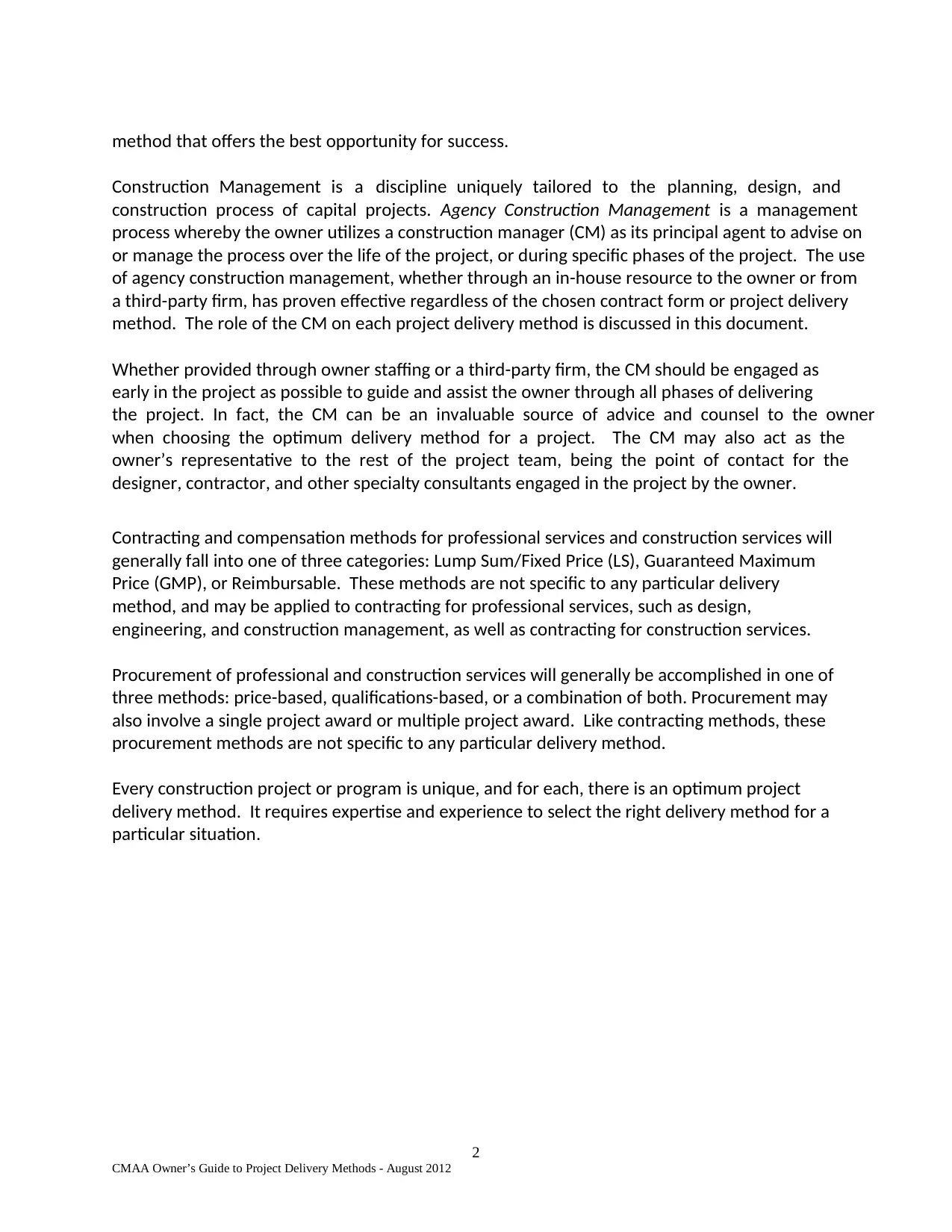
2
CMAA Owner’s Guide to Project Delivery Methods - August 2012
method that offers the best opportunity for success.
Construction Management is a discipline uniquely tailored to the planning, design, and
construction process of capital projects. Agency Construction Management is a management
process whereby the owner utilizes a construction manager (CM) as its principal agent to advise on
or manage the process over the life of the project, or during specific phases of the project. The use
of agency construction management, whether through an in-house resource to the owner or from
a third-party firm, has proven effective regardless of the chosen contract form or project delivery
method. The role of the CM on each project delivery method is discussed in this document.
Whether provided through owner staffing or a third-party firm, the CM should be engaged as
early in the project as possible to guide and assist the owner through all phases of delivering
the project. In fact, the CM can be an invaluable source of advice and counsel to the owner
when choosing the optimum delivery method for a project. The CM may also act as the
owner’s representative to the rest of the project team, being the point of contact for the
designer, contractor, and other specialty consultants engaged in the project by the owner.
Contracting and compensation methods for professional services and construction services will
generally fall into one of three categories: Lump Sum/Fixed Price (LS), Guaranteed Maximum
Price (GMP), or Reimbursable. These methods are not specific to any particular delivery
method, and may be applied to contracting for professional services, such as design,
engineering, and construction management, as well as contracting for construction services.
Procurement of professional and construction services will generally be accomplished in one of
three methods: price-based, qualifications-based, or a combination of both. Procurement may
also involve a single project award or multiple project award. Like contracting methods, these
procurement methods are not specific to any particular delivery method.
Every construction project or program is unique, and for each, there is an optimum project
delivery method. It requires expertise and experience to select the right delivery method for a
particular situation.
CMAA Owner’s Guide to Project Delivery Methods - August 2012
method that offers the best opportunity for success.
Construction Management is a discipline uniquely tailored to the planning, design, and
construction process of capital projects. Agency Construction Management is a management
process whereby the owner utilizes a construction manager (CM) as its principal agent to advise on
or manage the process over the life of the project, or during specific phases of the project. The use
of agency construction management, whether through an in-house resource to the owner or from
a third-party firm, has proven effective regardless of the chosen contract form or project delivery
method. The role of the CM on each project delivery method is discussed in this document.
Whether provided through owner staffing or a third-party firm, the CM should be engaged as
early in the project as possible to guide and assist the owner through all phases of delivering
the project. In fact, the CM can be an invaluable source of advice and counsel to the owner
when choosing the optimum delivery method for a project. The CM may also act as the
owner’s representative to the rest of the project team, being the point of contact for the
designer, contractor, and other specialty consultants engaged in the project by the owner.
Contracting and compensation methods for professional services and construction services will
generally fall into one of three categories: Lump Sum/Fixed Price (LS), Guaranteed Maximum
Price (GMP), or Reimbursable. These methods are not specific to any particular delivery
method, and may be applied to contracting for professional services, such as design,
engineering, and construction management, as well as contracting for construction services.
Procurement of professional and construction services will generally be accomplished in one of
three methods: price-based, qualifications-based, or a combination of both. Procurement may
also involve a single project award or multiple project award. Like contracting methods, these
procurement methods are not specific to any particular delivery method.
Every construction project or program is unique, and for each, there is an optimum project
delivery method. It requires expertise and experience to select the right delivery method for a
particular situation.
⊘ This is a preview!⊘
Do you want full access?
Subscribe today to unlock all pages.

Trusted by 1+ million students worldwide
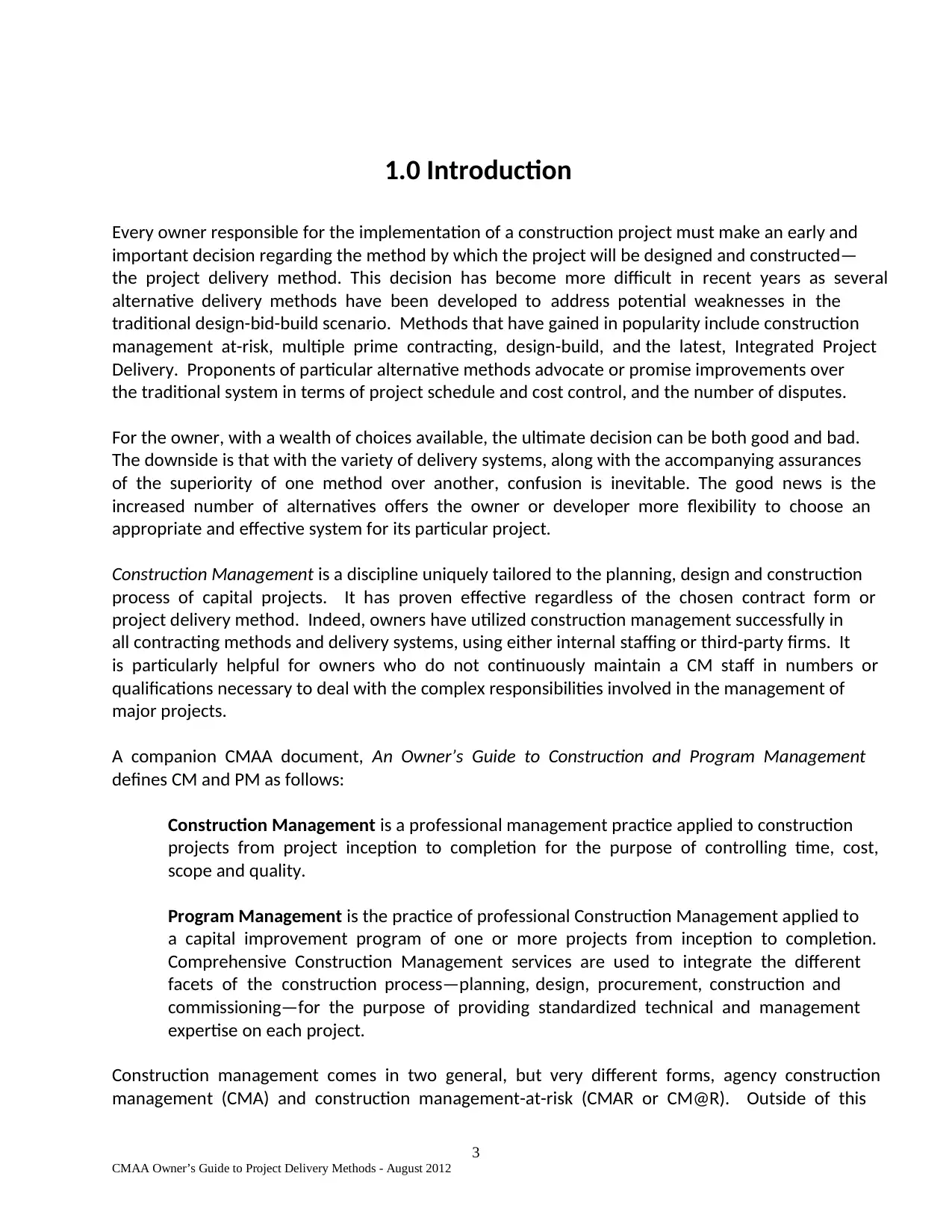
3
CMAA Owner’s Guide to Project Delivery Methods - August 2012
1.0 Introduction
Every owner responsible for the implementation of a construction project must make an early and
important decision regarding the method by which the project will be designed and constructed—
the project delivery method. This decision has become more difficult in recent years as several
alternative delivery methods have been developed to address potential weaknesses in the
traditional design-bid-build scenario. Methods that have gained in popularity include construction
management at-risk, multiple prime contracting, design-build, and the latest, Integrated Project
Delivery. Proponents of particular alternative methods advocate or promise improvements over
the traditional system in terms of project schedule and cost control, and the number of disputes.
For the owner, with a wealth of choices available, the ultimate decision can be both good and bad.
The downside is that with the variety of delivery systems, along with the accompanying assurances
of the superiority of one method over another, confusion is inevitable. The good news is the
increased number of alternatives offers the owner or developer more flexibility to choose an
appropriate and effective system for its particular project.
Construction Management is a discipline uniquely tailored to the planning, design and construction
process of capital projects. It has proven effective regardless of the chosen contract form or
project delivery method. Indeed, owners have utilized construction management successfully in
all contracting methods and delivery systems, using either internal staffing or third-party firms. It
is particularly helpful for owners who do not continuously maintain a CM staff in numbers or
qualifications necessary to deal with the complex responsibilities involved in the management of
major projects.
A companion CMAA document, An Owner’s Guide to Construction and Program Management
defines CM and PM as follows:
Construction Management is a professional management practice applied to construction
projects from project inception to completion for the purpose of controlling time, cost,
scope and quality.
Program Management is the practice of professional Construction Management applied to
a capital improvement program of one or more projects from inception to completion.
Comprehensive Construction Management services are used to integrate the different
facets of the construction process—planning, design, procurement, construction and
commissioning—for the purpose of providing standardized technical and management
expertise on each project.
Construction management comes in two general, but very different forms, agency construction
management (CMA) and construction management-at-risk (CMAR or CM@R). Outside of this
CMAA Owner’s Guide to Project Delivery Methods - August 2012
1.0 Introduction
Every owner responsible for the implementation of a construction project must make an early and
important decision regarding the method by which the project will be designed and constructed—
the project delivery method. This decision has become more difficult in recent years as several
alternative delivery methods have been developed to address potential weaknesses in the
traditional design-bid-build scenario. Methods that have gained in popularity include construction
management at-risk, multiple prime contracting, design-build, and the latest, Integrated Project
Delivery. Proponents of particular alternative methods advocate or promise improvements over
the traditional system in terms of project schedule and cost control, and the number of disputes.
For the owner, with a wealth of choices available, the ultimate decision can be both good and bad.
The downside is that with the variety of delivery systems, along with the accompanying assurances
of the superiority of one method over another, confusion is inevitable. The good news is the
increased number of alternatives offers the owner or developer more flexibility to choose an
appropriate and effective system for its particular project.
Construction Management is a discipline uniquely tailored to the planning, design and construction
process of capital projects. It has proven effective regardless of the chosen contract form or
project delivery method. Indeed, owners have utilized construction management successfully in
all contracting methods and delivery systems, using either internal staffing or third-party firms. It
is particularly helpful for owners who do not continuously maintain a CM staff in numbers or
qualifications necessary to deal with the complex responsibilities involved in the management of
major projects.
A companion CMAA document, An Owner’s Guide to Construction and Program Management
defines CM and PM as follows:
Construction Management is a professional management practice applied to construction
projects from project inception to completion for the purpose of controlling time, cost,
scope and quality.
Program Management is the practice of professional Construction Management applied to
a capital improvement program of one or more projects from inception to completion.
Comprehensive Construction Management services are used to integrate the different
facets of the construction process—planning, design, procurement, construction and
commissioning—for the purpose of providing standardized technical and management
expertise on each project.
Construction management comes in two general, but very different forms, agency construction
management (CMA) and construction management-at-risk (CMAR or CM@R). Outside of this
Paraphrase This Document
Need a fresh take? Get an instant paraphrase of this document with our AI Paraphraser
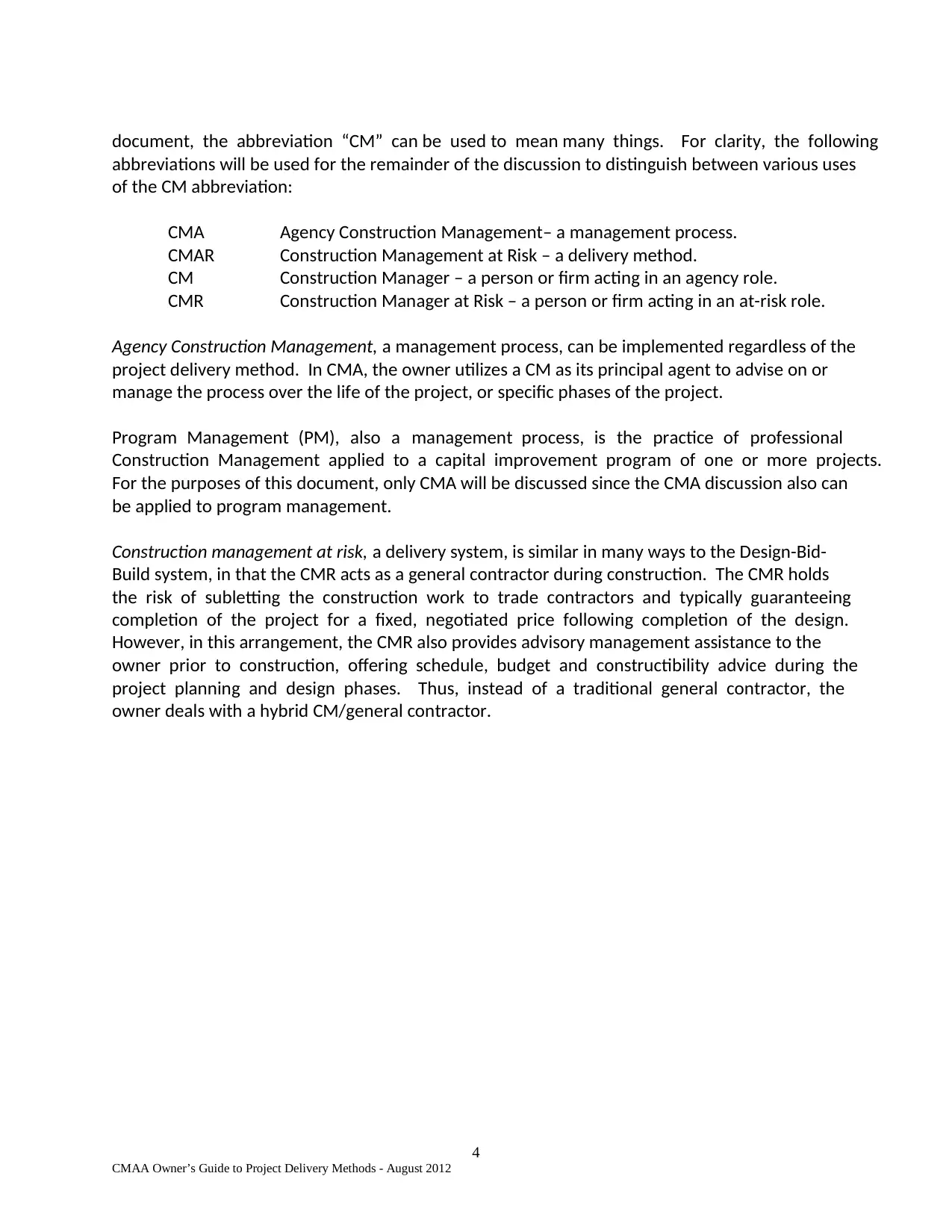
4
CMAA Owner’s Guide to Project Delivery Methods - August 2012
document, the abbreviation “CM” can be used to mean many things. For clarity, the following
abbreviations will be used for the remainder of the discussion to distinguish between various uses
of the CM abbreviation:
CMA Agency Construction Management– a management process.
CMAR Construction Management at Risk – a delivery method.
CM Construction Manager – a person or firm acting in an agency role.
CMR Construction Manager at Risk – a person or firm acting in an at-risk role.
Agency Construction Management, a management process, can be implemented regardless of the
project delivery method. In CMA, the owner utilizes a CM as its principal agent to advise on or
manage the process over the life of the project, or specific phases of the project.
Program Management (PM), also a management process, is the practice of professional
Construction Management applied to a capital improvement program of one or more projects.
For the purposes of this document, only CMA will be discussed since the CMA discussion also can
be applied to program management.
Construction management at risk, a delivery system, is similar in many ways to the Design-Bid-
Build system, in that the CMR acts as a general contractor during construction. The CMR holds
the risk of subletting the construction work to trade contractors and typically guaranteeing
completion of the project for a fixed, negotiated price following completion of the design.
However, in this arrangement, the CMR also provides advisory management assistance to the
owner prior to construction, offering schedule, budget and constructibility advice during the
project planning and design phases. Thus, instead of a traditional general contractor, the
owner deals with a hybrid CM/general contractor.
CMAA Owner’s Guide to Project Delivery Methods - August 2012
document, the abbreviation “CM” can be used to mean many things. For clarity, the following
abbreviations will be used for the remainder of the discussion to distinguish between various uses
of the CM abbreviation:
CMA Agency Construction Management– a management process.
CMAR Construction Management at Risk – a delivery method.
CM Construction Manager – a person or firm acting in an agency role.
CMR Construction Manager at Risk – a person or firm acting in an at-risk role.
Agency Construction Management, a management process, can be implemented regardless of the
project delivery method. In CMA, the owner utilizes a CM as its principal agent to advise on or
manage the process over the life of the project, or specific phases of the project.
Program Management (PM), also a management process, is the practice of professional
Construction Management applied to a capital improvement program of one or more projects.
For the purposes of this document, only CMA will be discussed since the CMA discussion also can
be applied to program management.
Construction management at risk, a delivery system, is similar in many ways to the Design-Bid-
Build system, in that the CMR acts as a general contractor during construction. The CMR holds
the risk of subletting the construction work to trade contractors and typically guaranteeing
completion of the project for a fixed, negotiated price following completion of the design.
However, in this arrangement, the CMR also provides advisory management assistance to the
owner prior to construction, offering schedule, budget and constructibility advice during the
project planning and design phases. Thus, instead of a traditional general contractor, the
owner deals with a hybrid CM/general contractor.
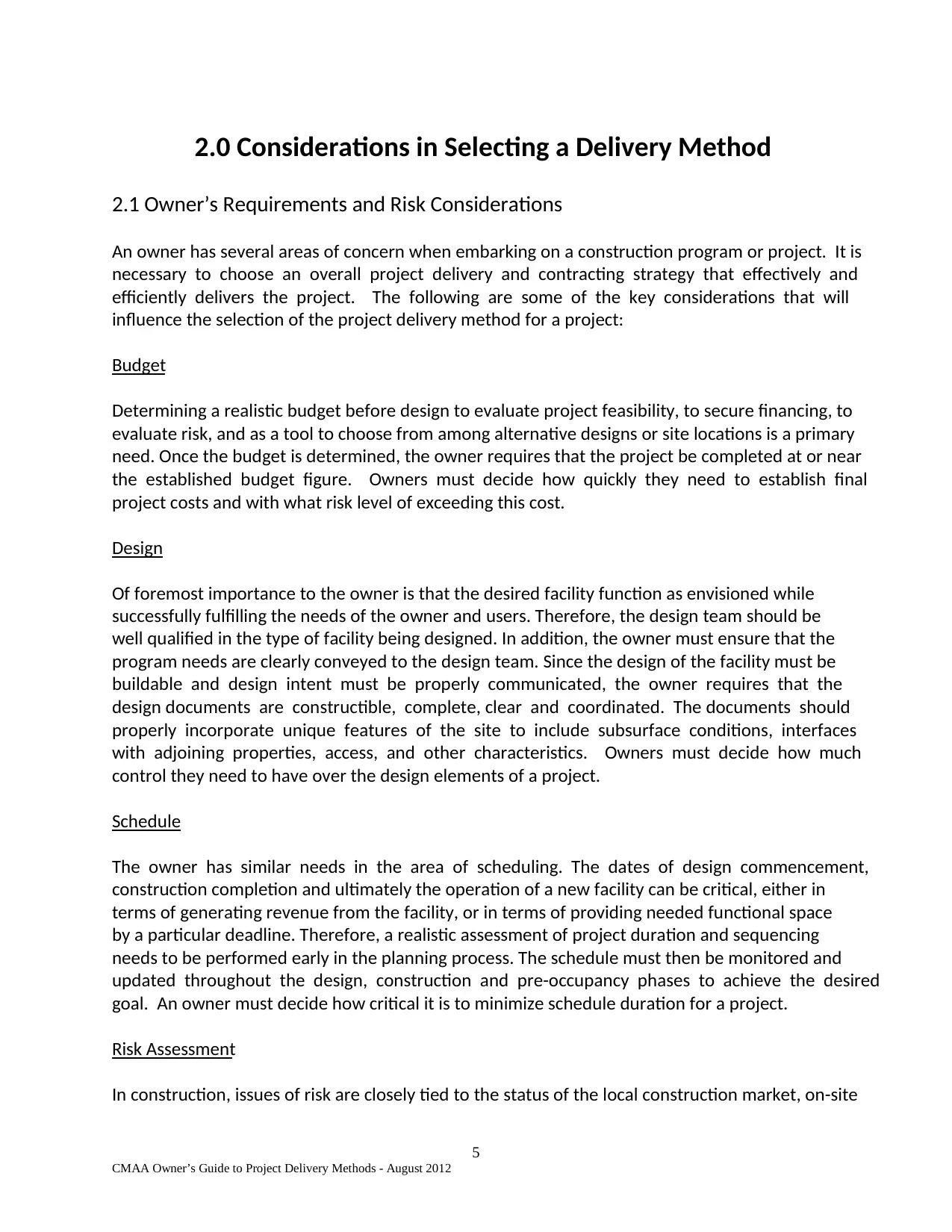
5
CMAA Owner’s Guide to Project Delivery Methods - August 2012
2.0 Considerations in Selecting a Delivery Method
2.1 Owner’s Requirements and Risk Considerations
An owner has several areas of concern when embarking on a construction program or project. It is
necessary to choose an overall project delivery and contracting strategy that effectively and
efficiently delivers the project. The following are some of the key considerations that will
influence the selection of the project delivery method for a project:
Budget
Determining a realistic budget before design to evaluate project feasibility, to secure financing, to
evaluate risk, and as a tool to choose from among alternative designs or site locations is a primary
need. Once the budget is determined, the owner requires that the project be completed at or near
the established budget figure. Owners must decide how quickly they need to establish final
project costs and with what risk level of exceeding this cost.
Design
Of foremost importance to the owner is that the desired facility function as envisioned while
successfully fulfilling the needs of the owner and users. Therefore, the design team should be
well qualified in the type of facility being designed. In addition, the owner must ensure that the
program needs are clearly conveyed to the design team. Since the design of the facility must be
buildable and design intent must be properly communicated, the owner requires that the
design documents are constructible, complete, clear and coordinated. The documents should
properly incorporate unique features of the site to include subsurface conditions, interfaces
with adjoining properties, access, and other characteristics. Owners must decide how much
control they need to have over the design elements of a project.
Schedule
The owner has similar needs in the area of scheduling. The dates of design commencement,
construction completion and ultimately the operation of a new facility can be critical, either in
terms of generating revenue from the facility, or in terms of providing needed functional space
by a particular deadline. Therefore, a realistic assessment of project duration and sequencing
needs to be performed early in the planning process. The schedule must then be monitored and
updated throughout the design, construction and pre-occupancy phases to achieve the desired
goal. An owner must decide how critical it is to minimize schedule duration for a project.
Risk Assessment
In construction, issues of risk are closely tied to the status of the local construction market, on-site
CMAA Owner’s Guide to Project Delivery Methods - August 2012
2.0 Considerations in Selecting a Delivery Method
2.1 Owner’s Requirements and Risk Considerations
An owner has several areas of concern when embarking on a construction program or project. It is
necessary to choose an overall project delivery and contracting strategy that effectively and
efficiently delivers the project. The following are some of the key considerations that will
influence the selection of the project delivery method for a project:
Budget
Determining a realistic budget before design to evaluate project feasibility, to secure financing, to
evaluate risk, and as a tool to choose from among alternative designs or site locations is a primary
need. Once the budget is determined, the owner requires that the project be completed at or near
the established budget figure. Owners must decide how quickly they need to establish final
project costs and with what risk level of exceeding this cost.
Design
Of foremost importance to the owner is that the desired facility function as envisioned while
successfully fulfilling the needs of the owner and users. Therefore, the design team should be
well qualified in the type of facility being designed. In addition, the owner must ensure that the
program needs are clearly conveyed to the design team. Since the design of the facility must be
buildable and design intent must be properly communicated, the owner requires that the
design documents are constructible, complete, clear and coordinated. The documents should
properly incorporate unique features of the site to include subsurface conditions, interfaces
with adjoining properties, access, and other characteristics. Owners must decide how much
control they need to have over the design elements of a project.
Schedule
The owner has similar needs in the area of scheduling. The dates of design commencement,
construction completion and ultimately the operation of a new facility can be critical, either in
terms of generating revenue from the facility, or in terms of providing needed functional space
by a particular deadline. Therefore, a realistic assessment of project duration and sequencing
needs to be performed early in the planning process. The schedule must then be monitored and
updated throughout the design, construction and pre-occupancy phases to achieve the desired
goal. An owner must decide how critical it is to minimize schedule duration for a project.
Risk Assessment
In construction, issues of risk are closely tied to the status of the local construction market, on-site
⊘ This is a preview!⊘
Do you want full access?
Subscribe today to unlock all pages.

Trusted by 1+ million students worldwide
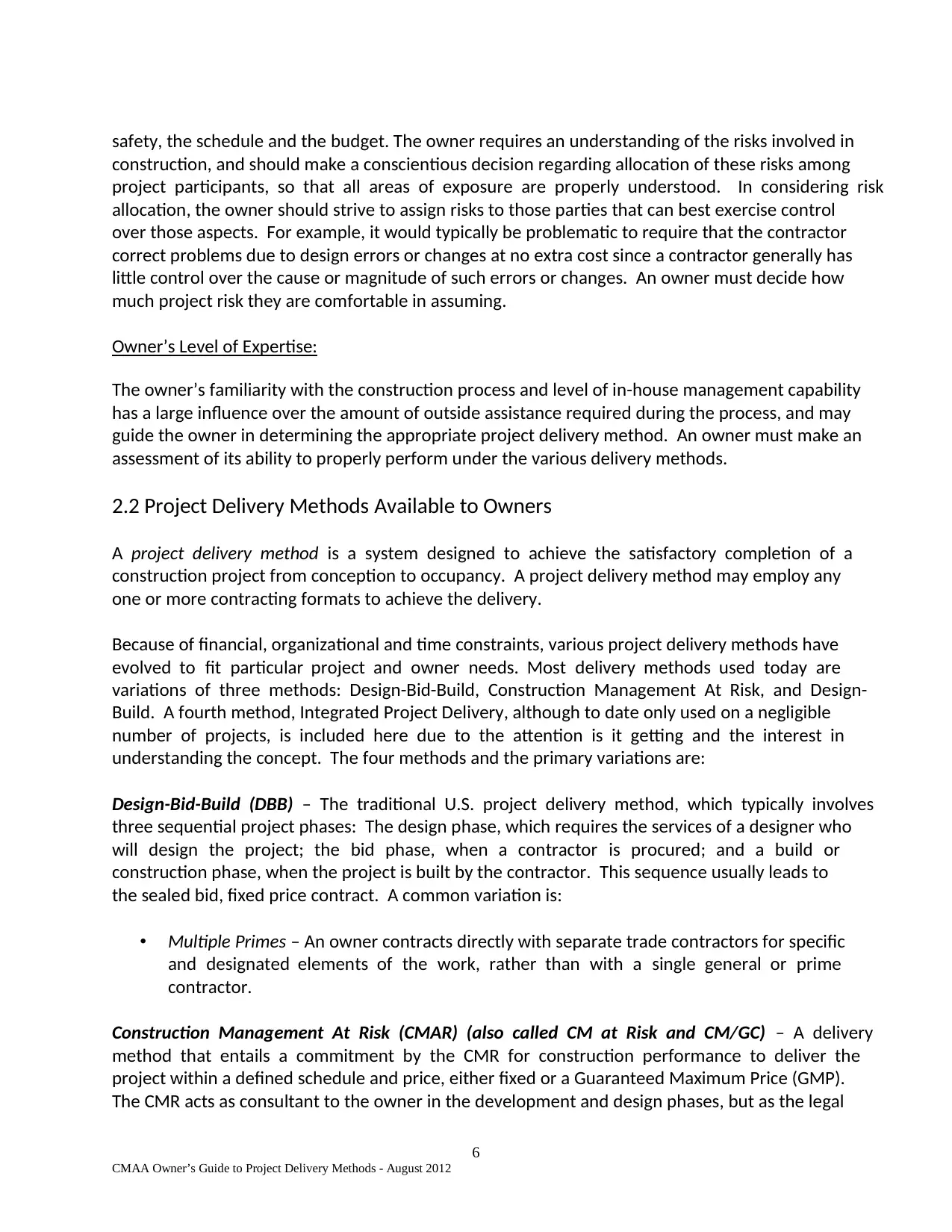
6
CMAA Owner’s Guide to Project Delivery Methods - August 2012
safety, the schedule and the budget. The owner requires an understanding of the risks involved in
construction, and should make a conscientious decision regarding allocation of these risks among
project participants, so that all areas of exposure are properly understood. In considering risk
allocation, the owner should strive to assign risks to those parties that can best exercise control
over those aspects. For example, it would typically be problematic to require that the contractor
correct problems due to design errors or changes at no extra cost since a contractor generally has
little control over the cause or magnitude of such errors or changes. An owner must decide how
much project risk they are comfortable in assuming.
Owner’s Level of Expertise:
The owner’s familiarity with the construction process and level of in-house management capability
has a large influence over the amount of outside assistance required during the process, and may
guide the owner in determining the appropriate project delivery method. An owner must make an
assessment of its ability to properly perform under the various delivery methods.
2.2 Project Delivery Methods Available to Owners
A project delivery method is a system designed to achieve the satisfactory completion of a
construction project from conception to occupancy. A project delivery method may employ any
one or more contracting formats to achieve the delivery.
Because of financial, organizational and time constraints, various project delivery methods have
evolved to fit particular project and owner needs. Most delivery methods used today are
variations of three methods: Design-Bid-Build, Construction Management At Risk, and Design-
Build. A fourth method, Integrated Project Delivery, although to date only used on a negligible
number of projects, is included here due to the attention is it getting and the interest in
understanding the concept. The four methods and the primary variations are:
Design-Bid-Build (DBB) – The traditional U.S. project delivery method, which typically involves
three sequential project phases: The design phase, which requires the services of a designer who
will design the project; the bid phase, when a contractor is procured; and a build or
construction phase, when the project is built by the contractor. This sequence usually leads to
the sealed bid, fixed price contract. A common variation is:
• Multiple Primes – An owner contracts directly with separate trade contractors for specific
and designated elements of the work, rather than with a single general or prime
contractor.
Construction Management At Risk (CMAR) (also called CM at Risk and CM/GC) – A delivery
method that entails a commitment by the CMR for construction performance to deliver the
project within a defined schedule and price, either fixed or a Guaranteed Maximum Price (GMP).
The CMR acts as consultant to the owner in the development and design phases, but as the legal
CMAA Owner’s Guide to Project Delivery Methods - August 2012
safety, the schedule and the budget. The owner requires an understanding of the risks involved in
construction, and should make a conscientious decision regarding allocation of these risks among
project participants, so that all areas of exposure are properly understood. In considering risk
allocation, the owner should strive to assign risks to those parties that can best exercise control
over those aspects. For example, it would typically be problematic to require that the contractor
correct problems due to design errors or changes at no extra cost since a contractor generally has
little control over the cause or magnitude of such errors or changes. An owner must decide how
much project risk they are comfortable in assuming.
Owner’s Level of Expertise:
The owner’s familiarity with the construction process and level of in-house management capability
has a large influence over the amount of outside assistance required during the process, and may
guide the owner in determining the appropriate project delivery method. An owner must make an
assessment of its ability to properly perform under the various delivery methods.
2.2 Project Delivery Methods Available to Owners
A project delivery method is a system designed to achieve the satisfactory completion of a
construction project from conception to occupancy. A project delivery method may employ any
one or more contracting formats to achieve the delivery.
Because of financial, organizational and time constraints, various project delivery methods have
evolved to fit particular project and owner needs. Most delivery methods used today are
variations of three methods: Design-Bid-Build, Construction Management At Risk, and Design-
Build. A fourth method, Integrated Project Delivery, although to date only used on a negligible
number of projects, is included here due to the attention is it getting and the interest in
understanding the concept. The four methods and the primary variations are:
Design-Bid-Build (DBB) – The traditional U.S. project delivery method, which typically involves
three sequential project phases: The design phase, which requires the services of a designer who
will design the project; the bid phase, when a contractor is procured; and a build or
construction phase, when the project is built by the contractor. This sequence usually leads to
the sealed bid, fixed price contract. A common variation is:
• Multiple Primes – An owner contracts directly with separate trade contractors for specific
and designated elements of the work, rather than with a single general or prime
contractor.
Construction Management At Risk (CMAR) (also called CM at Risk and CM/GC) – A delivery
method that entails a commitment by the CMR for construction performance to deliver the
project within a defined schedule and price, either fixed or a Guaranteed Maximum Price (GMP).
The CMR acts as consultant to the owner in the development and design phases, but as the legal
Paraphrase This Document
Need a fresh take? Get an instant paraphrase of this document with our AI Paraphraser
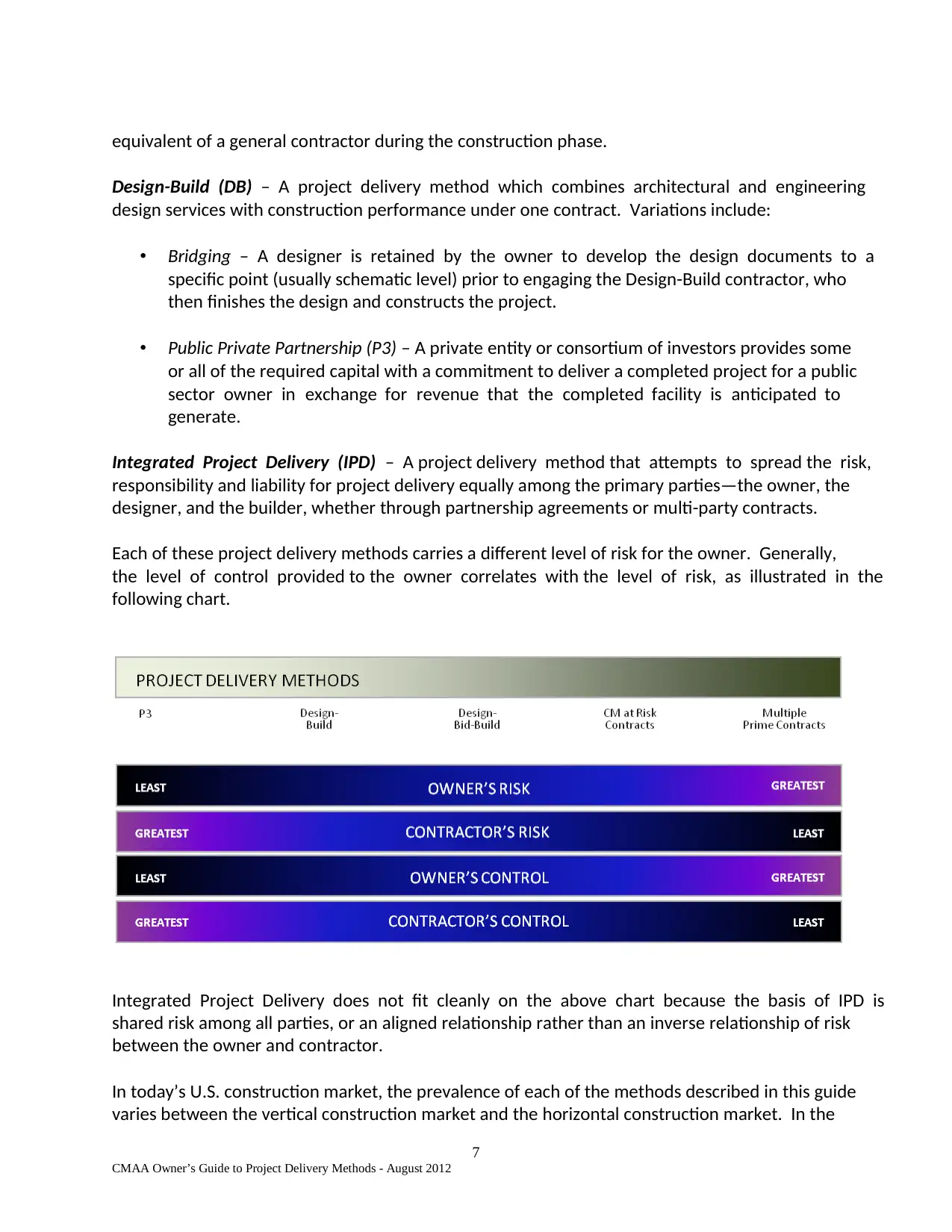
7
CMAA Owner’s Guide to Project Delivery Methods - August 2012
equivalent of a general contractor during the construction phase.
Design-Build (DB) – A project delivery method which combines architectural and engineering
design services with construction performance under one contract. Variations include:
• Bridging – A designer is retained by the owner to develop the design documents to a
specific point (usually schematic level) prior to engaging the Design-Build contractor, who
then finishes the design and constructs the project.
• Public Private Partnership (P3) – A private entity or consortium of investors provides some
or all of the required capital with a commitment to deliver a completed project for a public
sector owner in exchange for revenue that the completed facility is anticipated to
generate.
Integrated Project Delivery (IPD) – A project delivery method that attempts to spread the risk,
responsibility and liability for project delivery equally among the primary parties—the owner, the
designer, and the builder, whether through partnership agreements or multi-party contracts.
Each of these project delivery methods carries a different level of risk for the owner. Generally,
the level of control provided to the owner correlates with the level of risk, as illustrated in the
following chart.
Integrated Project Delivery does not fit cleanly on the above chart because the basis of IPD is
shared risk among all parties, or an aligned relationship rather than an inverse relationship of risk
between the owner and contractor.
In today’s U.S. construction market, the prevalence of each of the methods described in this guide
varies between the vertical construction market and the horizontal construction market. In the
CMAA Owner’s Guide to Project Delivery Methods - August 2012
equivalent of a general contractor during the construction phase.
Design-Build (DB) – A project delivery method which combines architectural and engineering
design services with construction performance under one contract. Variations include:
• Bridging – A designer is retained by the owner to develop the design documents to a
specific point (usually schematic level) prior to engaging the Design-Build contractor, who
then finishes the design and constructs the project.
• Public Private Partnership (P3) – A private entity or consortium of investors provides some
or all of the required capital with a commitment to deliver a completed project for a public
sector owner in exchange for revenue that the completed facility is anticipated to
generate.
Integrated Project Delivery (IPD) – A project delivery method that attempts to spread the risk,
responsibility and liability for project delivery equally among the primary parties—the owner, the
designer, and the builder, whether through partnership agreements or multi-party contracts.
Each of these project delivery methods carries a different level of risk for the owner. Generally,
the level of control provided to the owner correlates with the level of risk, as illustrated in the
following chart.
Integrated Project Delivery does not fit cleanly on the above chart because the basis of IPD is
shared risk among all parties, or an aligned relationship rather than an inverse relationship of risk
between the owner and contractor.
In today’s U.S. construction market, the prevalence of each of the methods described in this guide
varies between the vertical construction market and the horizontal construction market. In the
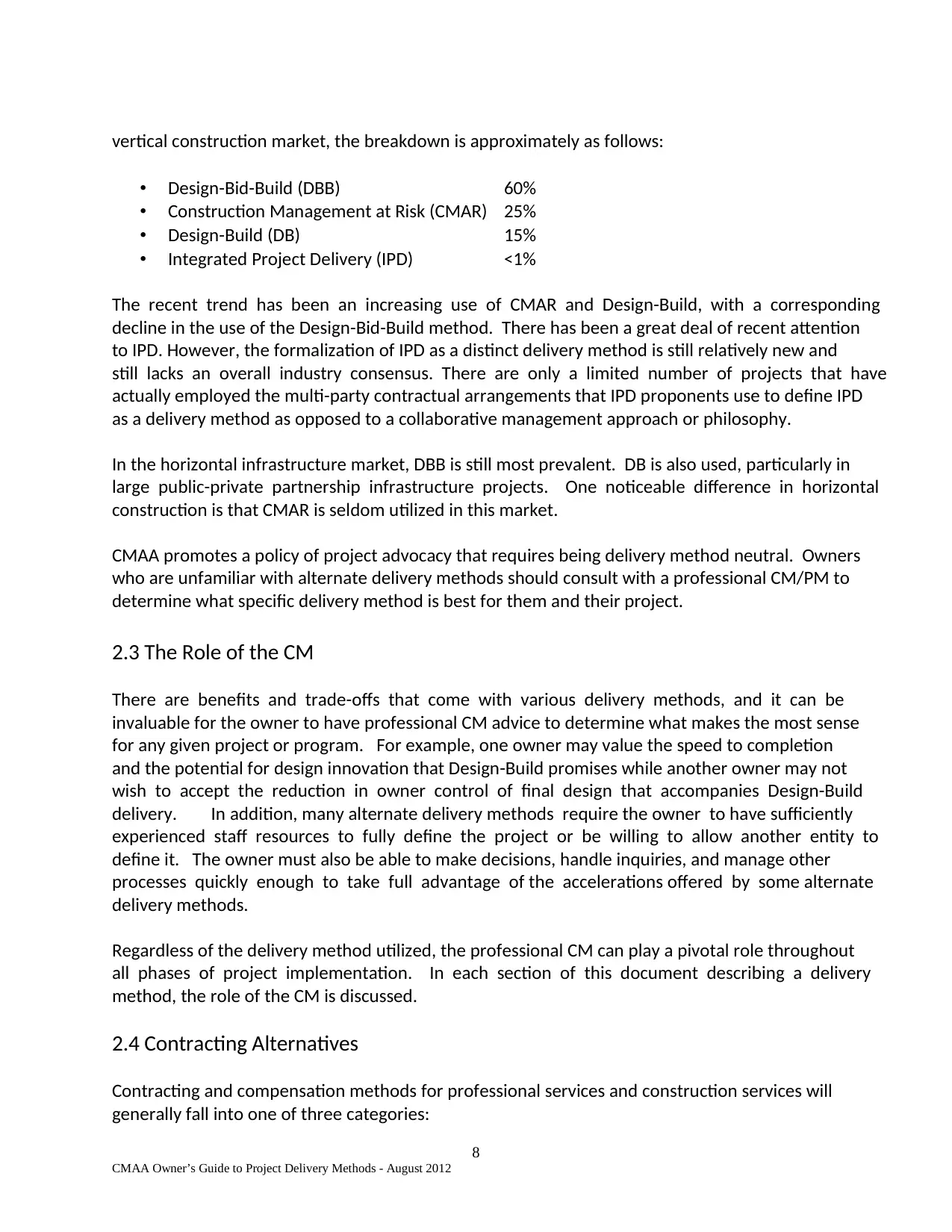
8
CMAA Owner’s Guide to Project Delivery Methods - August 2012
vertical construction market, the breakdown is approximately as follows:
• Design-Bid-Build (DBB) 60%
• Construction Management at Risk (CMAR) 25%
• Design-Build (DB) 15%
• Integrated Project Delivery (IPD) <1%
The recent trend has been an increasing use of CMAR and Design-Build, with a corresponding
decline in the use of the Design-Bid-Build method. There has been a great deal of recent attention
to IPD. However, the formalization of IPD as a distinct delivery method is still relatively new and
still lacks an overall industry consensus. There are only a limited number of projects that have
actually employed the multi-party contractual arrangements that IPD proponents use to define IPD
as a delivery method as opposed to a collaborative management approach or philosophy.
In the horizontal infrastructure market, DBB is still most prevalent. DB is also used, particularly in
large public-private partnership infrastructure projects. One noticeable difference in horizontal
construction is that CMAR is seldom utilized in this market.
CMAA promotes a policy of project advocacy that requires being delivery method neutral. Owners
who are unfamiliar with alternate delivery methods should consult with a professional CM/PM to
determine what specific delivery method is best for them and their project.
2.3 The Role of the CM
There are benefits and trade-offs that come with various delivery methods, and it can be
invaluable for the owner to have professional CM advice to determine what makes the most sense
for any given project or program. For example, one owner may value the speed to completion
and the potential for design innovation that Design-Build promises while another owner may not
wish to accept the reduction in owner control of final design that accompanies Design-Build
delivery. In addition, many alternate delivery methods require the owner to have sufficiently
experienced staff resources to fully define the project or be willing to allow another entity to
define it. The owner must also be able to make decisions, handle inquiries, and manage other
processes quickly enough to take full advantage of the accelerations offered by some alternate
delivery methods.
Regardless of the delivery method utilized, the professional CM can play a pivotal role throughout
all phases of project implementation. In each section of this document describing a delivery
method, the role of the CM is discussed.
2.4 Contracting Alternatives
Contracting and compensation methods for professional services and construction services will
generally fall into one of three categories:
CMAA Owner’s Guide to Project Delivery Methods - August 2012
vertical construction market, the breakdown is approximately as follows:
• Design-Bid-Build (DBB) 60%
• Construction Management at Risk (CMAR) 25%
• Design-Build (DB) 15%
• Integrated Project Delivery (IPD) <1%
The recent trend has been an increasing use of CMAR and Design-Build, with a corresponding
decline in the use of the Design-Bid-Build method. There has been a great deal of recent attention
to IPD. However, the formalization of IPD as a distinct delivery method is still relatively new and
still lacks an overall industry consensus. There are only a limited number of projects that have
actually employed the multi-party contractual arrangements that IPD proponents use to define IPD
as a delivery method as opposed to a collaborative management approach or philosophy.
In the horizontal infrastructure market, DBB is still most prevalent. DB is also used, particularly in
large public-private partnership infrastructure projects. One noticeable difference in horizontal
construction is that CMAR is seldom utilized in this market.
CMAA promotes a policy of project advocacy that requires being delivery method neutral. Owners
who are unfamiliar with alternate delivery methods should consult with a professional CM/PM to
determine what specific delivery method is best for them and their project.
2.3 The Role of the CM
There are benefits and trade-offs that come with various delivery methods, and it can be
invaluable for the owner to have professional CM advice to determine what makes the most sense
for any given project or program. For example, one owner may value the speed to completion
and the potential for design innovation that Design-Build promises while another owner may not
wish to accept the reduction in owner control of final design that accompanies Design-Build
delivery. In addition, many alternate delivery methods require the owner to have sufficiently
experienced staff resources to fully define the project or be willing to allow another entity to
define it. The owner must also be able to make decisions, handle inquiries, and manage other
processes quickly enough to take full advantage of the accelerations offered by some alternate
delivery methods.
Regardless of the delivery method utilized, the professional CM can play a pivotal role throughout
all phases of project implementation. In each section of this document describing a delivery
method, the role of the CM is discussed.
2.4 Contracting Alternatives
Contracting and compensation methods for professional services and construction services will
generally fall into one of three categories:
⊘ This is a preview!⊘
Do you want full access?
Subscribe today to unlock all pages.

Trusted by 1+ million students worldwide
1 out of 35
Related Documents
Your All-in-One AI-Powered Toolkit for Academic Success.
+13062052269
info@desklib.com
Available 24*7 on WhatsApp / Email
![[object Object]](/_next/static/media/star-bottom.7253800d.svg)
Unlock your academic potential
Copyright © 2020–2025 A2Z Services. All Rights Reserved. Developed and managed by ZUCOL.




